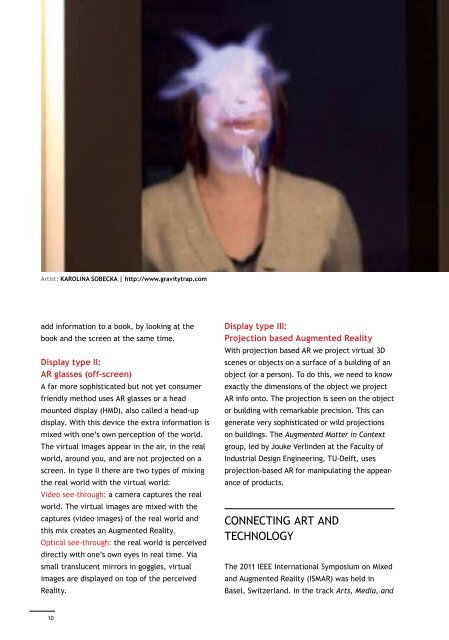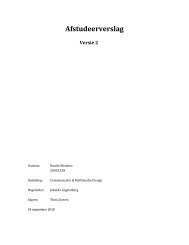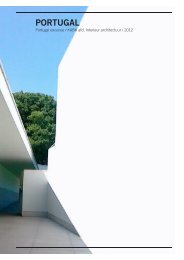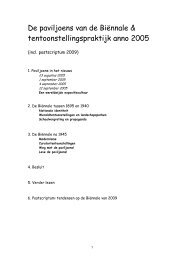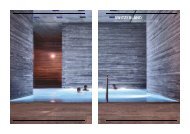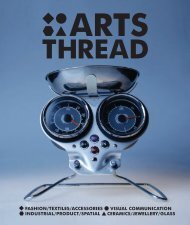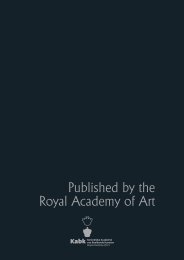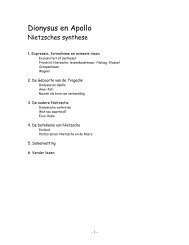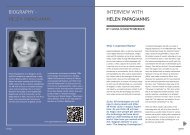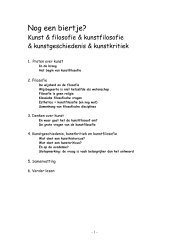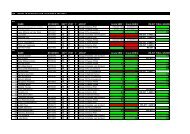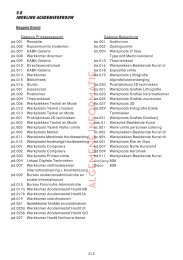download LR pdf - Kabk
download LR pdf - Kabk
download LR pdf - Kabk
You also want an ePaper? Increase the reach of your titles
YUMPU automatically turns print PDFs into web optimized ePapers that Google loves.
Artist: KAROLINA SOBECKA | http://www.gravitytrap.comadd information to a book, by looking at thebook and the screen at the same time.Display type II:AR glasses (off-screen)A far more sophisticated but not yet consumerfriendly method uses AR glasses or a headmounted display (HMD), also called a head-updisplay. With this device the extra information ismixed with one’s own perception of the world.The virtual images appear in the air, in the realworld, around you, and are not projected on ascreen. In type II there are two types of mixingthe real world with the virtual world:Video see-through: a camera captures the realworld. The virtual images are mixed with thecaptures (video images) of the real world andthis mix creates an Augmented Reality.Optical see-through: the real world is perceiveddirectly with one’s own eyes in real time. Viasmall translucent mirrors in goggles, virtualimages are displayed on top of the perceivedReality.Display type III:Projection based Augmented RealityWith projection based AR we project virtual 3Dscenes or objects on a surface of a building of anobject (or a person). To do this, we need to knowexactly the dimensions of the object we projectAR info onto. The projection is seen on the objector building with remarkable precision. This cangenerate very sophisticated or wild projectionson buildings. The Augmented Matter in Contextgroup, led by Jouke Verlinden at the Faculty ofIndustrial Design Engineering, TU-Delft, usespro jection-based AR for manipulating the appearanceof products.Connecting art andTechnologyThe 2011 IEEE International Symposium on Mixedand Augmented Reality (ISMAR) was held inBasel, Switzerland. In the track Arts, Media, andHumanities, 40 articles were offered discussingthe connection of ‘hard’ physics and ‘soft’ art.There are several ways in which art and AugmentedReality technology can be connected:we can, for example, make art with AugmentedReality technology, create Augmented Realityartworks or use Augmented Reality technologyto show and explain existing art (such as amonument like the Greek Pantheon or paintingsfrom the grottos of Lascaux). Most of the contributionsof the conference concerned AugmentedReality as a tool to present, explain or augmentexisting art. However, some visual artists use ARas a medium to create art.The role of the artist in working with the emergingtechnology of Augmented Reality has beendiscussed by Helen Papagiannis in her ISMARpaper The Role of the Artist in Evolving AR as aNew Medium (2011). In her paper, Helen Papagiannisreviews how the use of technology as a creativemedium has been discussed in recent years.She points out, that in 1988 John Pearson wroteabout how the computer offers artists “newmeans for expressing their ideas” (p.73., cited inPapagiannis, 2011, p.61). According to Pearson,“Technology has always been, the handmaiden ofthe visual arts, as is obvious, a technical means isalways necessary for the visual communication ofideas, of expression or the development of worksof art—tools and materials are required.” (p. 73)However, he points out that new technologies“were not developed by the artistic communityfor artistic purposes, but by science and industryto serve the pragmatic or utilitarian needs ofsociety.” (p.73., cited in Papagiannis, 2011, p.61)As Helen Papagiannis concludes, it is then up tothe artist “to act as a pioneer, pushing forwarda new aesthetic that exploits the unique materialsof the novel technology” (2011, p.61). LikeHelen, we believe this holds also for the emergingfield of AR technologies and we hope, artists willset out to create exciting new Augmented Realityart and thereby contribute to the interplaybetween art and technology. An interview withHelen Papagiannis can be found on page 12 of thismagazine. A portrait of the artist Marina de Haas,who did a residency at the AR Lab, can be foundon page 60.REFERENCES■ Milgram P. and Kishino, F., “A Taxonomy ofMixed Reality Visual Displays,” IEICE Trans.Information Systems, vol. E77-D, no. 12, 1994,pp. 1321-1329.■ Azuma, Ronald T., “A Survey of AugmentedReality”. In Presence: Teleoperators andVirtual Environments 6, 4 (August 1997),pp. 355-385.■ Papagiannis, H., “The Role of the Artistin Evolving AR as a New Medium”, 2011IEEE International Symposium on Mixed andAugmented Reality(ISMAR) – Arts, Media, andHumanities (ISMAR-AMH), Basel, Switserland,pp. 61-65.■ Pearson, J., “The computer: Liberator orJailer of The creative Spirit.” Leonardo,Supplemental Issue, Electronic Art, 1 (1988),pp. 73-80.10 11


